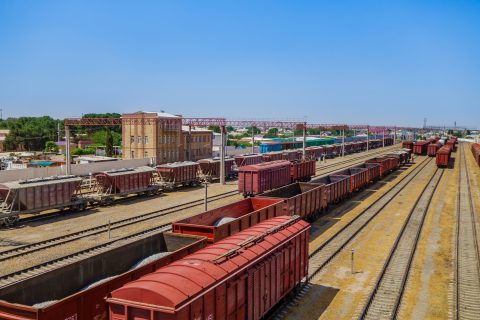Rail sector ‘losing ground’ warns Hupac despite its record 2016

Swiss intermodal operator Hupac is warning of serious challenges facing the European rail freight sector as a result of poor international cooperation over infrastructure and planning. This is despite it recording 737,000 rail movements in 2016, helping ensure that for the first time in 20 years, fewer than one million trucks crossed the Alps.
But low fuel prices and automative innovations means rail freight is still ‘noticeably losing ground’ to road transport, it said. The company said it needed to look at cutting costs and increasing train capacities to tackle impending national subsidy cuts.
Core market
In its core market of transalpine consignments through Switzerland, Hupac’s traffic grew by 19.4 per cent last year, through a combination of the four-metre trailer market operated by its Shuttle Net division, and the Company Shuttle Division, which operates block trains for major customers. Around 110 trains were in use every day, between Europe and Russia and, increasingly, the Far East.
The growth strategy Hupac adopted in 2015 has delivered economic success, with annual profits of 10.8 million Swiss Francs last year, and a 6.2 per cent increase in the number employees, up to 429. However it has been preparing for the abolition of Swiss subsidies for combined traffic at the end of 2023, and that lower production costs and more payload-per-train ‘was the motto’ for the future.
Intentions
The company, which celebrated its 70th anniversary in 2016, signalled its intentions this week with the ordering of eight Vectron MS locomotives from Siemens. The ETCS-equipped locos, with a top speed of 160 km/h, will serve the key Benelux-Germany-Austria-Switzerland corridors, and will be delivered from the summer of 2018.
Hans-Jörg Bertschi, chairman of Hupac Ltd, said: “The parameters of 2000-tonne train weight with one engine, 740-metre train length and 4-metre profile are the basic prerequisites for a cost-effective operation of the combined traffic. In order to compensate for the abolition of Swiss subsidies from 2023, we have to increase productivity continuously and at all levels.
‘Losing ground’
“While road markedly improves its competitiveness through low diesel prices and innumerable innovations, rail is noticeably losing ground,” he added.
Hupac said that two-thirds of the value of current subsidies could be offset if infrastructures were consistently upgraded along the length of the Alpine corridor, but as things stood ‘these could not be guaranteed’. One-third could not be compensated for, which presented a ‘serious risk’ for combined traffic in transit through Switzerland. Numerous construction sites in the rail network will also pose a burden in the coming years, with problems arising from a lack of international coordination and a poor assessment of market requirements.
‘Delayed integration’
Concerns have also been raised about the new Gotthard base tunnel, which began operations in December, which despite ‘progressing smoothly’, has also seen ‘delayed international integration’. The heavy freight trains passing through the Gotthard tunnel, said Hupac, need one locomotive less on the flat track via Luino, and this important productivity gain will only be possible on the route via Chiasso from 2020, when the Ceneri base tunnel starts operation.
“It has not yet been possible to achieve shorter travelling times in international traffic,” said Bertschi. “In the Benelux-Germany-Switzerland-Italy corridor, the same timetables are being used as 2015, (and) 90 per cent of the potential savings time is offset by waiting. An internationally-agreed train path-planning, which will pass on the advances in productivity from the Gotthard base tunnel to the market, is still in its infancy.”
Route plan
The company has called for a unilaterally-agreed route plan for Swiss transit along the Benelux/Germany/Switzerland/Italy freight corridor to help achieve the aspired effect of the ‘NEAT’ system, which aims to plan and set the frequencies of route capacities. “If the trains run instead of waiting at the the border, everybody wins; the tracks are free, locomotives and drivers can be more productively deployed, the rotation of the wagons improves, terminal slots are used better and the customers are happy,” it said in a statement.
“Halving the train path prices for freight traffic, as is currently under discussion in Germany, is a clear signal with an immediate effect on modal shift,” added Hans-Jörg Bertschi. “Switzerland, with its considerably high train path prices, should shake this transparent and discrimination-free modal shift tool into consideration.”
You just read one of our premium articles free of charge
Want full access? Take advantage of our exclusive offer





